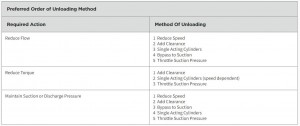1.Why need capacity and load control?
The pressure and flow conditions for which the compressor is designed and/or operated can vary across a wide range. The three primary reasons for changing the capacity of a compressor are process flow requirements, suction or discharge pressure management, or load management due changing pressure conditions and driver power limitations.
2.Capacity and load control methods
Several methods can be used to reduce the effective capacity of a compressor. The “best practice” order of the unloading method is included in the table below.

(1)The use of driver speed for control can be one of the most effective methods for capacity reduction and suction and/or discharge pressure management. The available power of the driver will decrease as the speed is decreased. The compressor power efficiency increases as the speed decreases due to lower gas velocities creating lower valve and cylinder losses.
(2) The addition of clearance will reduce capacity and required power through a decrease in the volumetric efficiency of the cylinder. Methods of adding clearance are the following:
-High Clearance Valve Assembly
-Variable Volume Clearance Pockets
-Pneumatic Fixed Volume Clearance Pockets
-Double Deck Valve Volume Pockets
(3) Single acting cylinder operation will reduce capacity through cylinder end deactivation. Cylinder head end deactivation can be accomplished by removing the head end suction valves, installing head end Suction Valve Unloaders, or installing a head end bypass unloader. Refer to Single Acting Cylinder configuration for further information.
(4) Bypass to suction is the recycling (bypassing) of gas from the discharge back to suction. This reduces the downstream capacity. Bypassing gas from discharge back to suction does not reduce the power consumption (unless fully bypasses for zero flow downstream).
(5) Suction throttling (artificially lowering the suction pressure) reduces the capacity by lowering the actual flow into the first stage cylinder. Suction throttling can reduce power consumption, but may have an impact on the discharge temperatures and rod loads generated by the higher compression ratio
3.Impact of capacity control on compressor performance.
Capacity control methods can have an impact on various performance characteristics besides flow and power. Partial load conditions should be reviewed for acceptable performance including valve lift selection and dynamics, volumetric efficiency, discharge temperatures, rod reversal, gas rod loads, torsional and acoustical response.
Automated capacity control sequences must be communicated so that the same set of loading steps is considered in the acoustical analysis, torsional analysis and control panel logic.
Post time: Jul-11-2022

